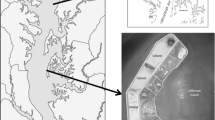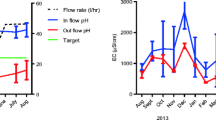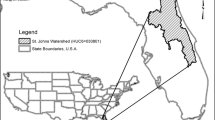Abstract
A comparison of two methods for restoring dredged canals to wetlands was examined at the Jean Lafitte National Historical Park and Preserve’s Barataria Preserve Unit near New Orleans, LA. Both northern and southern canals had the remnant dredged spoil material returned to the canal, but the southern canal had additional sediment pumped in from a nearby lake. The water depth in the southern canal shallowed significantly from 1.2 to 0.4 m following backfilling and sediment addition, while the depth of the northern canal (which received no additional sediment) remained unchanged following backfilling. Neither site had complete soil restoration, but the former spoil areas of the northern canal showed greater restoration than the southern canal. The vegetation on the former spoil areas of the northern canal closely resembled that of the reference marsh, while the former spoil areas of the southern canal had species indicative of spoil banks and other elevated areas. After 3 years wetland vegetation was established on approximately 65% of the former spoil areas at both sites and 20–25% of the open water areas. Sediment addition to the southern canal raised costs by a factor of eight times compared to that of the northern canal. The results of this study document the restoration potential of both methods, but also show that backfilling without supplemental sediment additions can restore abandoned canals at a fraction of the cost of other methods.




Similar content being viewed by others
References
Baumann RH, Turner RE (1990) Direct impacts of outer continental shelf activities on wetland loss in the central Gulf of Mexico. Environ Geol Water Resour 15:189–198. doi:10.1007/BF01706410
Baustian JJ, Turner RE (2006) Restoration success of backfilling canals in coastal Louisiana marshes. Restor Ecol 14:634–644. doi:10.1111/j.1526-100X.2006.00175.x
Louisiana Department of Natural Resources (1995) Coastal wetlands planning, protection and restoration act: summary of priority lists 1–4. CWPPRA report series no. 1. Louisiana Department of Natural Resources, Baton Rouge
Morton TA, Bernier JC, Barras JA, Ferina NF (2005) Rapid subsidence and historical wetland loss in the Mississippi delta plain: likely causes and future implications. USGS open-file report 2005-1215
National Park Service (2000) Management policies (2001). Department of the Interior, National Park Service, Washington DC, NPS D1416
Neill C, Turner RE (1987) Backfilling canals to mitigate wetland dredging in Louisiana coastal marshes. Environ Manag 11:823–836. doi:10.1007/BF01867248
Nelson DW, Sommers LE (1996) Total carbon, organic carbon, and organic matter. In: Bartels JM, Bigham JM (eds) Methods of soil analysis. Part 3. Chemical methods. Soil Science Society of America and American Society of Agronomy, Madison, WI, USA, pp 961–1010
O’Neil T (1949) The Muskrat in the Louisiana coastal marshes. Louisiana Department of Wild Life and Fisheries, New Orleans
Reed DJ, Rozas LP (1995) An evaluation of the potential for infilling existing pipeline canals in Louisiana coastal marshes. Estuaries 15:149–158
SAS Institute Inc (2003) The SAS system for Windows, version 9.1. Cary, North Carolina, USA
Stephens JC, Allen LH, Chen E (1984) Organic soil subsidence. In: Holzer T (ed) Geological society of American reviews in engineering geology, vol VI. The Geological Society of America, Boulder, pp 107–122
Turner RE (1987) Relationship between canal and levee density and coastal land loss in Louisiana. U S Fish Wildl Serv Biol Rep 85(14):58
Turner RE (1997) Wetland loss in the northern gulf of Mexico: multiple working hypotheses. Estuaries 20:1–13. doi:10.2307/1352716
Turner RE, Streever B (2002) Approaches to coastal wetland restoration: northern gulf of Mexico. SPB Academic Publishing, Den Hague
Turner RE, Lee JM, Neill C (1994) Backfilling canals to restore wetlands: empirical results in coastal Louisiana. Wetl Ecol Manag 3:63–78. doi:10.1007/BF00177297
Acknowledgment
We thank the following people who helped in the permit preparation, data collection and monitoring of the project: Kate Carpenter (LSU), James M. Lee (LSU), Erick M. Swenson (LSU), Sandra Dingman, Scott Nesbitt and William J. Hulslander (the Preserve). We would also like to thank the two reviewers for their thoughtful comments on this manuscript. The NPS—Geological Resources Division provided project support and funding.
Author information
Authors and Affiliations
Corresponding author
Rights and permissions
About this article
Cite this article
Baustian, J.J., Turner, R.E., Walters, N.F. et al. Restoration of dredged canals in wetlands: a comparison of methods. Wetlands Ecol Manage 17, 445–453 (2009). https://doi.org/10.1007/s11273-008-9122-6
Received:
Accepted:
Published:
Issue Date:
DOI: https://doi.org/10.1007/s11273-008-9122-6




